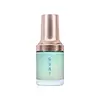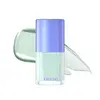What's inside
What's inside
 Key Ingredients
Key Ingredients

 Benefits
Benefits

 Concerns
Concerns

 Ingredients Side-by-side
Ingredients Side-by-side

Water
Skin ConditioningDimethicone
EmollientGlycerin
HumectantSilica
AbrasiveButylene Glycol
HumectantPropanediol
SolventMethyl Trimethicone
Skin ConditioningPEG-60 Hydrogenated Castor Oil
EmulsifyingCamellia Japonica Flower Extract
EmollientCentella Asiatica Extract
CleansingMoringa Oleifera Seed Oil
EmollientAtractylodes Macrocephala Root Extract
Skin ConditioningBletilla Striata Root Extract
Skin ConditioningAmpelopsis Japonica Root Extract
Skin ConditioningPaeonia Officinalis Flower Extract
TonicSalvia Miltiorrhiza Root Extract
Skin ConditioningRosa Damascena Flower Oil
MaskingPentylene Glycol
Skin ConditioningAlumina
AbrasivePolymethylsilsesquioxane
Dimethicone/Vinyl Dimethicone Crosspolymer
Skin ConditioningAcrylates/C10-30 Alkyl Acrylate Crosspolymer
Emulsion StabilisingTromethamine
BufferingPhenoxyethanol
PreservativeBHT
AntioxidantTin Oxide
AbrasiveDisodium EDTA
Olea Europaea Fruit Oil
MaskingTriethoxycaprylylsilane
Dipropylene Glycol
HumectantCeramide AP
Skin Conditioning1,2-Hexanediol
Skin ConditioningTocopherol
AntioxidantCI 42090
Cosmetic ColorantCI 77891
Cosmetic ColorantMica
Cosmetic ColorantCI 19140
Cosmetic ColorantWater, Dimethicone, Glycerin, Silica, Butylene Glycol, Propanediol, Methyl Trimethicone, PEG-60 Hydrogenated Castor Oil, Camellia Japonica Flower Extract, Centella Asiatica Extract, Moringa Oleifera Seed Oil, Atractylodes Macrocephala Root Extract, Bletilla Striata Root Extract, Ampelopsis Japonica Root Extract, Paeonia Officinalis Flower Extract, Salvia Miltiorrhiza Root Extract, Rosa Damascena Flower Oil, Pentylene Glycol, Alumina, Polymethylsilsesquioxane, Dimethicone/Vinyl Dimethicone Crosspolymer, Acrylates/C10-30 Alkyl Acrylate Crosspolymer, Tromethamine, Phenoxyethanol, BHT, Tin Oxide, Disodium EDTA, Olea Europaea Fruit Oil, Triethoxycaprylylsilane, Dipropylene Glycol, Ceramide AP, 1,2-Hexanediol, Tocopherol, CI 42090, CI 77891, Mica, CI 19140
Water
Skin ConditioningGlycerin
HumectantMethyl Trimethicone
Skin ConditioningOctyldodecyl Stearoyl Stearate
EmollientPentaerythrityl Stearate/Caprate/Caprylate/Adipate
EmollientCI 77891
Cosmetic ColorantHydrogenated Polydecene
EmollientPentylene Glycol
Skin Conditioning1,2-Hexanediol
Skin ConditioningHydrogenated Olive Oil
Skin ConditioningOlea Europaea Fruit Oil
MaskingOlea Europaea Oil Unsaponifiables
Skin ConditioningOpuntia Coccinellifera Fruit Extract
Skin ConditioningSodium Hyaluronate
HumectantChitosan
Hydrolyzed Hyaluronic Acid
HumectantHyaluronic Acid
HumectantPolymethylsilsesquioxane
Trimethylsiloxysilicate
EmollientAmmonium Acryloyldimethyltaurate/Vp Copolymer
Betaine
HumectantBisabolol
MaskingIsododecane
EmollientPotassium Cetyl Phosphate
EmulsifyingHydroxyethyl Acrylate/Sodium Acryloyldimethyl Taurate Copolymer
Emulsion StabilisingSorbitan Sesquioleate
EmulsifyingPanthenol
Skin ConditioningGlyceryl Caprylate
EmollientSilica
AbrasiveC12-20 Alkyl Glucoside
EmulsifyingAluminum Hydroxide
EmollientSodium Acrylate/Sodium Acryloyldimethyl Taurate Copolymer
Emulsion StabilisingTriethoxycaprylylsilane
Polyisobutene
Adenosine
Skin ConditioningTrisodium Ethylenediamine Disuccinate
Caprylyl/Capryl Glucoside
CleansingSorbitan Oleate
EmulsifyingBeta-Glucan
Skin ConditioningButylene Glycol
HumectantDipropylene Glycol
HumectantPropanediol
SolventHydrogenated Lecithin
EmulsifyingCholesterol
EmollientBenzyl Glycol
SolventHydrolyzed Glycosaminoglycans
HumectantCeramide NP
Skin ConditioningHydroxypropyltrimonium Hyaluronate
Sodium Hyaluronate Crosspolymer
HumectantEthylhexylglycerin
Skin ConditioningSodium Acetylated Hyaluronate
HumectantHydrolyzed Sodium Hyaluronate
Skin ConditioningPotassium Hyaluronate
Skin ConditioningC14-22 Alcohols
Emulsion StabilisingCetearyl Alcohol
EmollientParfum
MaskingAlpha-Isomethyl Ionone
PerfumingLinalool
PerfumingCI 77288
Cosmetic ColorantWater, Glycerin, Methyl Trimethicone, Octyldodecyl Stearoyl Stearate, Pentaerythrityl Stearate/Caprate/Caprylate/Adipate, CI 77891, Hydrogenated Polydecene, Pentylene Glycol, 1,2-Hexanediol, Hydrogenated Olive Oil, Olea Europaea Fruit Oil, Olea Europaea Oil Unsaponifiables, Opuntia Coccinellifera Fruit Extract, Sodium Hyaluronate, Chitosan, Hydrolyzed Hyaluronic Acid, Hyaluronic Acid, Polymethylsilsesquioxane, Trimethylsiloxysilicate, Ammonium Acryloyldimethyltaurate/Vp Copolymer, Betaine, Bisabolol, Isododecane, Potassium Cetyl Phosphate, Hydroxyethyl Acrylate/Sodium Acryloyldimethyl Taurate Copolymer, Sorbitan Sesquioleate, Panthenol, Glyceryl Caprylate, Silica, C12-20 Alkyl Glucoside, Aluminum Hydroxide, Sodium Acrylate/Sodium Acryloyldimethyl Taurate Copolymer, Triethoxycaprylylsilane, Polyisobutene, Adenosine, Trisodium Ethylenediamine Disuccinate, Caprylyl/Capryl Glucoside, Sorbitan Oleate, Beta-Glucan, Butylene Glycol, Dipropylene Glycol, Propanediol, Hydrogenated Lecithin, Cholesterol, Benzyl Glycol, Hydrolyzed Glycosaminoglycans, Ceramide NP, Hydroxypropyltrimonium Hyaluronate, Sodium Hyaluronate Crosspolymer, Ethylhexylglycerin, Sodium Acetylated Hyaluronate, Hydrolyzed Sodium Hyaluronate, Potassium Hyaluronate, C14-22 Alcohols, Cetearyl Alcohol, Parfum, Alpha-Isomethyl Ionone, Linalool, CI 77288
 Reviews
Reviews

Ingredients Explained
These ingredients are found in both products.
Ingredients higher up in an ingredient list are typically present in a larger amount.
1,2-Hexanediol is a synthetic liquid and another multi-functional powerhouse.
It is a:
- Humectant, drawing moisture into the skin
- Emollient, helping to soften skin
- Solvent, dispersing and stabilizing formulas
- Preservative booster, enhancing the antimicrobial activity of other preservatives
Butylene Glycol (or BG) is used within cosmetic products for a few different reasons:
Overall, Butylene Glycol is a safe and well-rounded ingredient that works well with other ingredients.
Though this ingredient works well with most skin types, some people with sensitive skin may experience a reaction such as allergic rashes, closed comedones, or itchiness.
Learn more about Butylene GlycolCi 77891 is a white pigment from Titanium dioxide. It is naturally found in minerals such as rutile and ilmenite.
It's main function is to add a white color to cosmetics. It can also be mixed with other colors to create different shades.
Ci 77891 is commonly found in sunscreens due to its ability to block UV rays.
Learn more about CI 77891Dipropylene Glycol is a synthetically created humectant, stabilizer, and solvent.
This ingredient helps:
Dipropylene glycol is technically an alcohol, but it belongs to the glycol family (often considered part of the ‘good’ alcohols). This means it is hydrating and gentle on skin unlike drying solvent alcohols like denatured alcohol.
As a masking agent, Dipropylene Glycol can be used to cover the smell of other ingredients. However, it does not have a scent.
Studies show Dipropylene Glycol is considered safe to use in skincare.
Learn more about Dipropylene GlycolGlycerin is already naturally found in your skin. It helps moisturize and protect your skin.
A study from 2016 found glycerin to be more effective as a humectant than AHAs and hyaluronic acid.
As a humectant, it helps the skin stay hydrated by pulling moisture to your skin. The low molecular weight of glycerin allows it to pull moisture into the deeper layers of your skin.
Hydrated skin improves your skin barrier; Your skin barrier helps protect against irritants and bacteria.
Glycerin has also been found to have antimicrobial and antiviral properties. Due to these properties, glycerin is often used in wound and burn treatments.
In cosmetics, glycerin is usually derived from plants such as soybean or palm. However, it can also be sourced from animals, such as tallow or animal fat.
This ingredient is organic, colorless, odorless, and non-toxic.
Glycerin is the name for this ingredient in American English. British English uses Glycerol/Glycerine.
Learn more about GlycerinMethyl Trimethicone is a type of silicone. It is a solvent and emulsifier.
Solvents are used to keep ingredients together in a product. They can help dissolve ingredients to stable bases or help evenly distribute ingredients throughout the product.
Emulsifiers help stabilize a product. It does this by preventing certain ingredients from separating.
Methyl Trimethicone does not get absorbed into the skin.
Learn more about Methyl TrimethiconeOlea Europaea Fruit Oil is the fixed oil obtained from the ripe fruit of the Olive. In other words - olive oil.
The primary contents of olive oil are glycerides of the fatty acids linoleic, oleic and palmitic.
Olive oil also contains antioxidants such as Vitamin E. Antioxidants may help reduce signs of aging by fighting unstable free-radical molecules. It also contains Vitamins A (retinol), D, and K.
The squalene in olive oil makes it a great emollient. Emollients help soothe and soften your skin by trapping moisture in. This makes olive oil a great skin moisturizer.
Studies show olive oil to have antibacterial and antifungal properties in low concentrations. Another study found olive oil irritated sensitive oily skin. We always recommend speaking with a professional about using this ingredient in your routine.
Due to the fatty acid content, this ingredient may not be fungal-acne safe.
Learn more about Olea Europaea Fruit OilPentylene glycol is typically used within a product to thicken it. It also adds a smooth, soft, and moisturizing feel to the product. It is naturally found in plants such as sugar beets.
The hydrophilic trait of Pentylene Glycol makes it a humectant. As a humectant, Pentylene Glycol helps draw moisture from the air to your skin. This can help keep your skin hydrated.
This property also makes Pentylene Glycol a great texture enhancer. It can also help thicken or stabilize a product.
Pentylene Glycol also acts as a mild preservative and helps to keep a product microbe-free.
Some people may experience mild eye and skin irritation from Pentylene Glycol. We always recommend speaking with a professional about using this ingredient in your routine.
Pentylene Glycol has a low molecular weight and is part of the 1,2-glycol family.
Learn more about Pentylene GlycolPolymethylsilsesquioxane is a silicone used as a film forming agent.
When applied to the skin, this ingredient creates an invisible film on the surface. This film still allows oxygen to pass through, but prevents moisture from escaping. This can help condition and hydrate the skin. It also leaves a silky feel when applied.
Polymethylsilsesquioxane has not been shown to clog pores. It has been deemed safe to use up to 55%, but most cosmetics use much less.
If you have concerns about using this ingredient, we recommend speaking with a professional.
Learn more about PolymethylsilsesquioxanePropanediol is an all-star ingredient. It softens, hydrates, and smooths the skin.
It’s often used to:
Propanediol is not likely to cause sensitivity and considered safe to use. It is derived from corn or petroleum with a clear color and no scent.
Learn more about PropanediolSilica, also known as silicon dioxide, is a naturally occurring mineral. It is used as a fine, spherical, and porous powder in cosmetics.
Though it has exfoliant properties, the function of silica varies depending on the product.
The unique structure of silica enhances the spreadability and adds smoothness, making it a great texture enhancer.
It is also used as an active carrier, emulsifier, and mattifier due to its ability to absorb excess oil.
In some products, tiny microneedles called spicules are made from silica or hydrolyzed sponge. When you rub them in, they lightly polish away dead skin layers and enhance the penetration of active ingredients.
Learn more about SilicaTriethoxycaprylylsilane is a silicone used to bind and stabilize ingredients.
As an emulsifier, it helps prevent ingredients from separating. This can help elongate the shelf life of products.
Triethoxycaprylylsilane is often used to coat mineral sunscreens ingredients to help give a better feel. It also helps reduce oxidative stress in sunscreens.
Learn more about TriethoxycaprylylsilaneWater. It's the most common cosmetic ingredient of all. You'll usually see it at the top of ingredient lists, meaning that it makes up the largest part of the product.
So why is it so popular? Water most often acts as a solvent - this means that it helps dissolve other ingredients into the formulation.
You'll also recognize water as that liquid we all need to stay alive. If you see this, drink a glass of water. Stay hydrated!
Learn more about Water